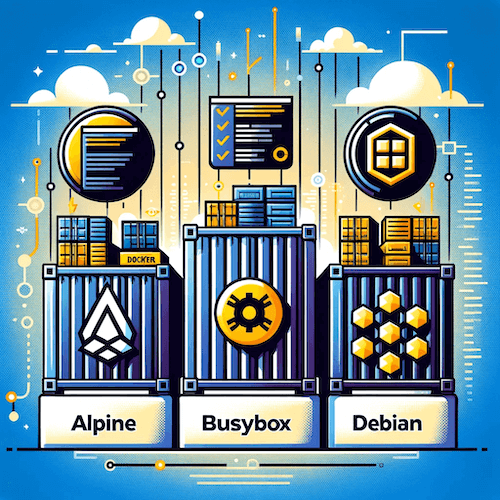Table of Content

Introduction
In the dynamic world of containerization, selecting the right Docker image is crucial for optimal performance and efficiency. This guide offers a detailed comparison of Alpine, BusyBox, and Debian Docker images, focusing on their sizes, strengths, and ideal use cases to help you make an informed decision.
Alpine Linux Docker Image
Alpine Linux is a minimalist Docker image known for its small footprint and efficiency. Designed to be simple and secure, it is built around musl libc and busybox. This makes Alpine Linux an ideal choice for those looking to create lightweight containers without unnecessary extras, prioritizing resource efficiency and a reduced attack surface.
Size: Approximately 5MB.
| Pros | Cons |
|---|---|
| Lightweight and Efficient | Limited Functionality |
| Security-Focused | Specific Adaptations Required |
| Resource Efficiency |
Ideal Use Cases
- Perfect for microservices where efficiency is key.
- Suitable for CI/CD pipelines focusing on speed and minimal resource usage.
BusyBox Docker Image
BusyBox is an extremely lightweight Unix toolset. It combines several common UNIX utilities into a single small executable, providing the necessary tools for managing UNIX environments while taking up minimal space. BusyBox is often used in embedded systems and minimalistic environments, making it a preferred choice for applications where every byte counts.
Size: Around 2MB.
| Pros | Cons |
|---|---|
| Ultra-Lightweight | Basic Functionality |
| Simplicity | Specific Applications |
| Versatility |
Ideal Use Cases
- Ideal for embedded systems and IoT devices where space efficiency is critical.
- Best suited for applications requiring only basic Unix functionalities.
Debian Docker Image
Debian is a robust and stable Linux distribution and a popular base for Docker images. Known for its large repository of precompiled packages and its focus on stability and security, Debian is a versatile choice for a wide range of applications. Its comprehensive package support and well-tested releases make it a reliable foundation for production environments, despite its larger size compared to Alpine and BusyBox.
Size: Typically between 100MB and 150MB.
| Pros | Cons |
|---|---|
| Feature-Rich | Larger Size |
| Stable and Reliable | Higher Resource Demand |
| Extensive Community Support |
Ideal Use Cases
- A go-to choice for general-purpose applications needing a broad range of functionalities.
- Suitable in scenarios where stability and extensive package support are crucial.
Conclusion
Choosing between Alpine, BusyBox, and Debian for Docker images should be based on your specific project needs. Alpine excels in lightweight, minimalist applications; BusyBox is optimal for ultra-minimalistic environments; while Debian is ideal for comprehensive, feature-rich applications. Understanding their differences is key to selecting the most appropriate Docker image for your containerization strategy.
| Feature | Alpine Linux | BusyBox | Debian |
|---|---|---|---|
| Size | ~5MB | ~2MB | ~100MB - 150MB |
| Pros | - Lightweight - Security-focused - Resource-efficient |
- Extremely lightweight - Simplicity - Versatility |
- Rich feature set - Stability - Strong community |
| Cons | - Limited functionality - Learning curve |
- Limited functionality - Not ideal for standard apps |
- Larger size - Higher resource usage |
| Best for | - Microservices - Speed & resource-efficient CI/CD |
- Embedded systems - Minimalistic applications |
- General-purpose apps - Stability-focused environments |
| Common Issues | - Compatibility with musl libc- Adaptation for busybox |
- Simplified tools lack advanced features | - Larger image size leads to longer deployment times |
| Solutions | - Use glibc compatibility layers- Adapt |